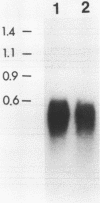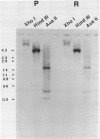Abstract
cDNA clones encoding the murine senile amyloid protein (ASSAM) have been isolated from animal models of accelerated senescence (SAM-P/1) and from normal aging (SAM-R/1). Immunochemical and protein sequence studies revealed that apolipoprotein (apo) A-II is a serum precursor of ASSAM. A 17-base synthetic oligonucleotide based on residues 39-44 of ASSAM was used as a hybridization probe for screening newly constructed SAM-P/1 and SAM-R/1 liver cDNA libraries. The structure of murine apo A-II cDNA is of interest because of the amino acid substitution found in ASSAM and serum apo A-II of SAM-P; in SAM-R or other random bred slc:ICR mice, amino acid residue 5 of mature apo A-II is proline but, in SAM-P, this amino acid is changed to glutamine. This amino acid replacement is caused by two nucleotide substitutions (CCA for proline codon to CAG for glutamine codon). The third base mutation may not be relevant to the substitution of amino acid. Attention is directed to the relation of this amino acid substitution to the specific deposition of apo A-II, as a tissue amyloid fibril.
Full text
PDF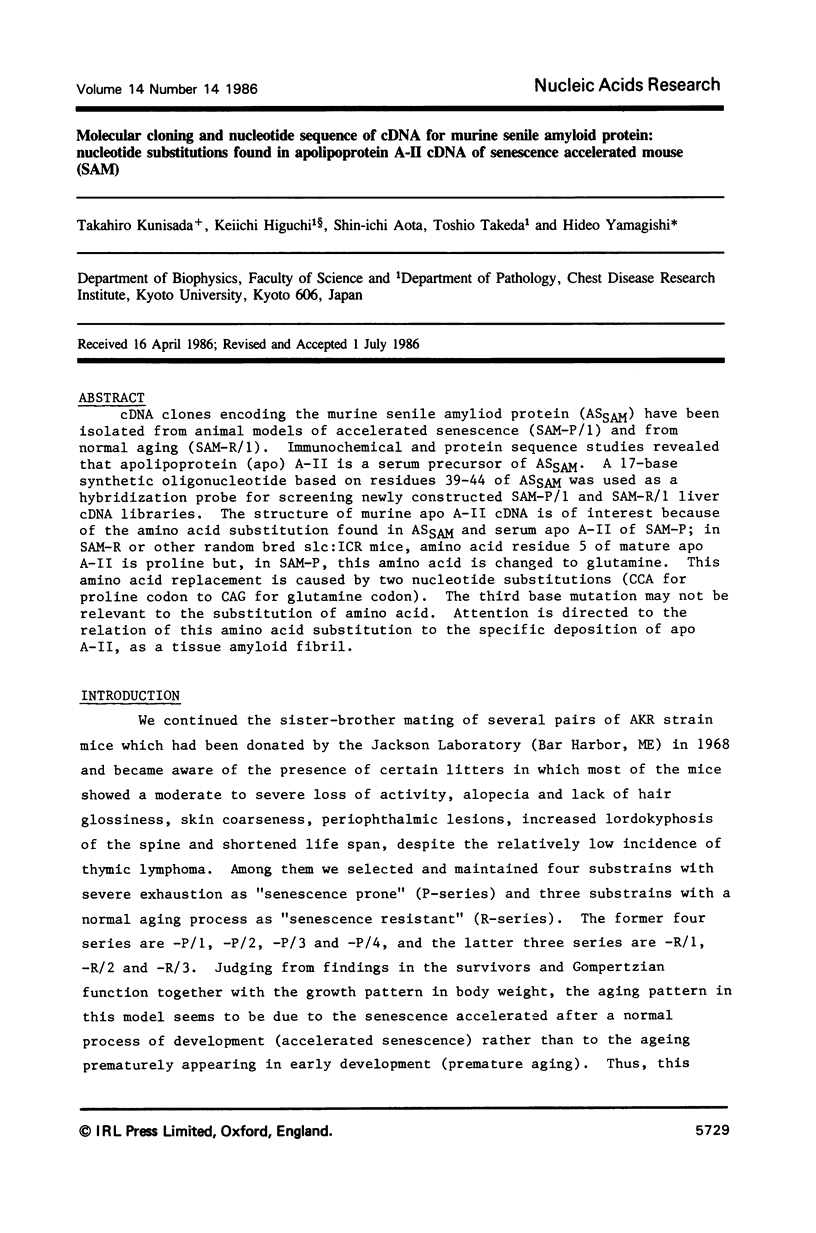

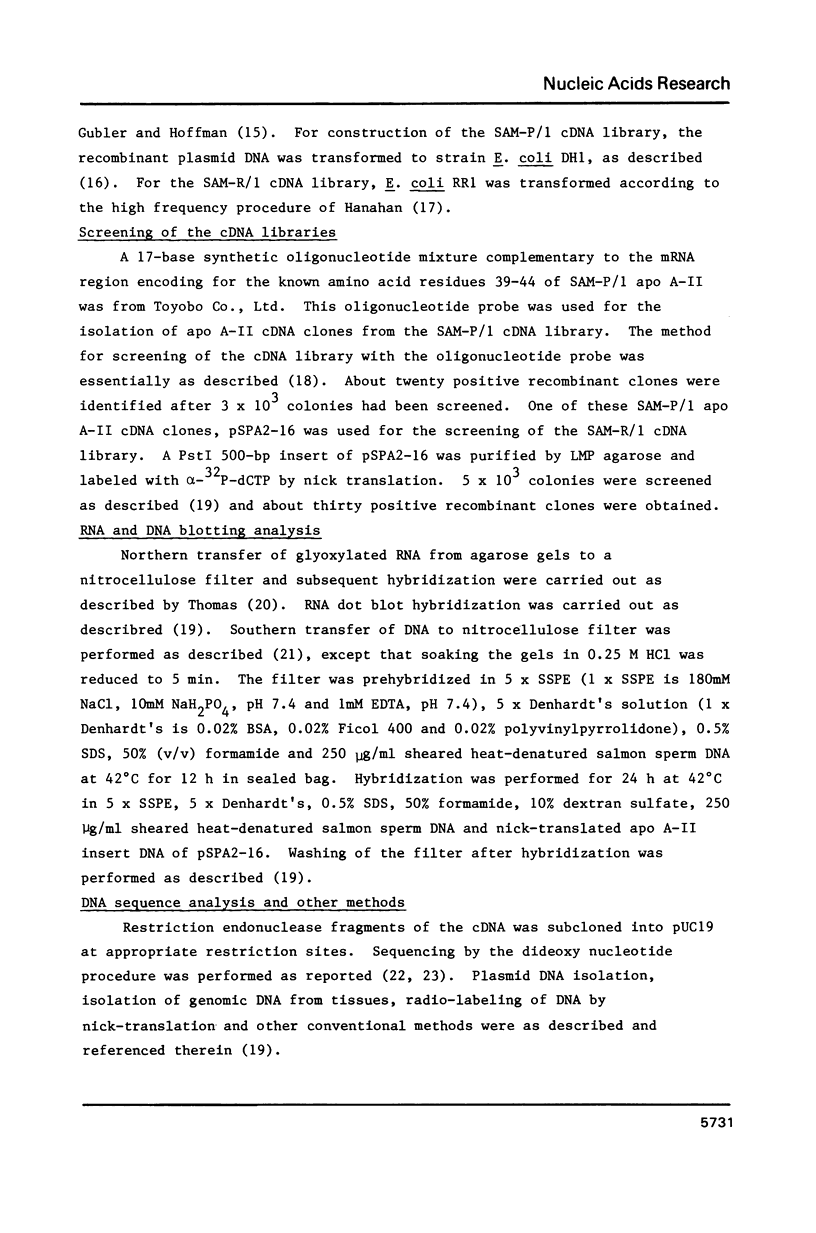
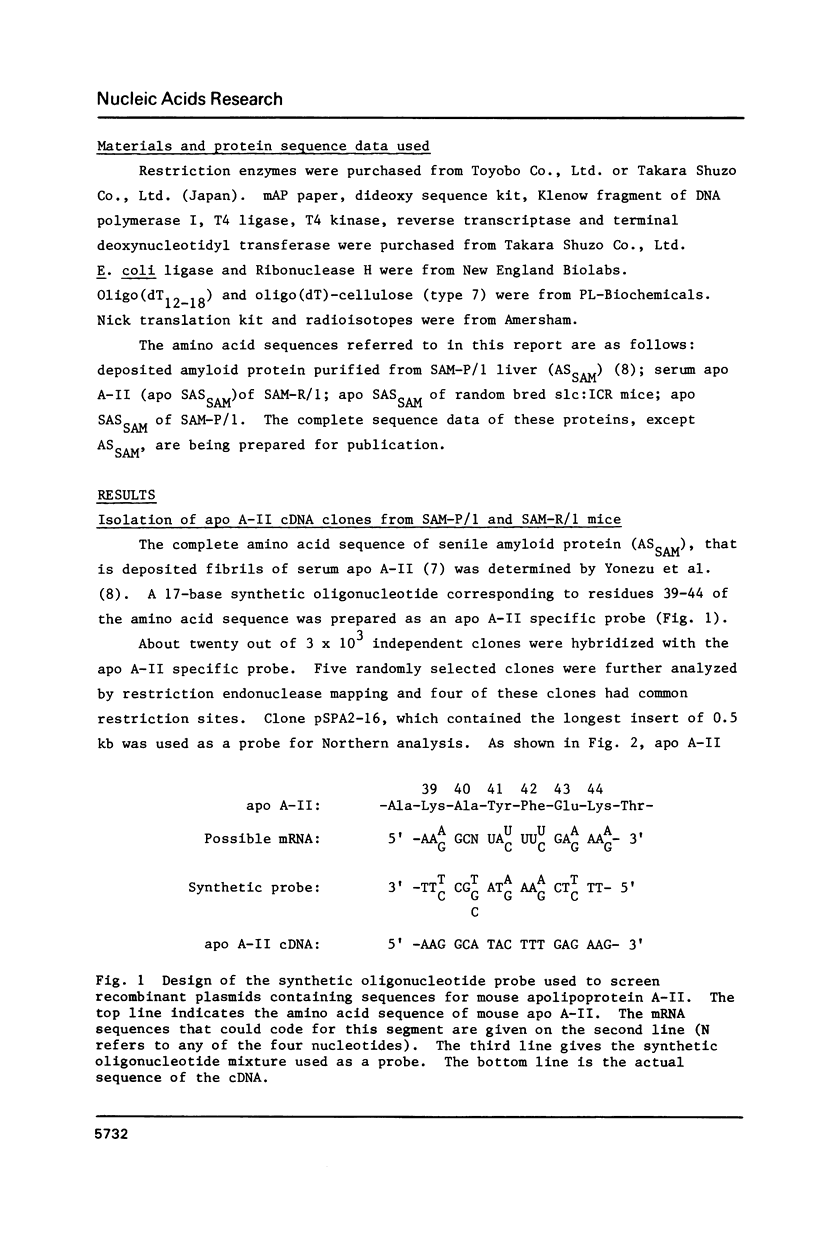
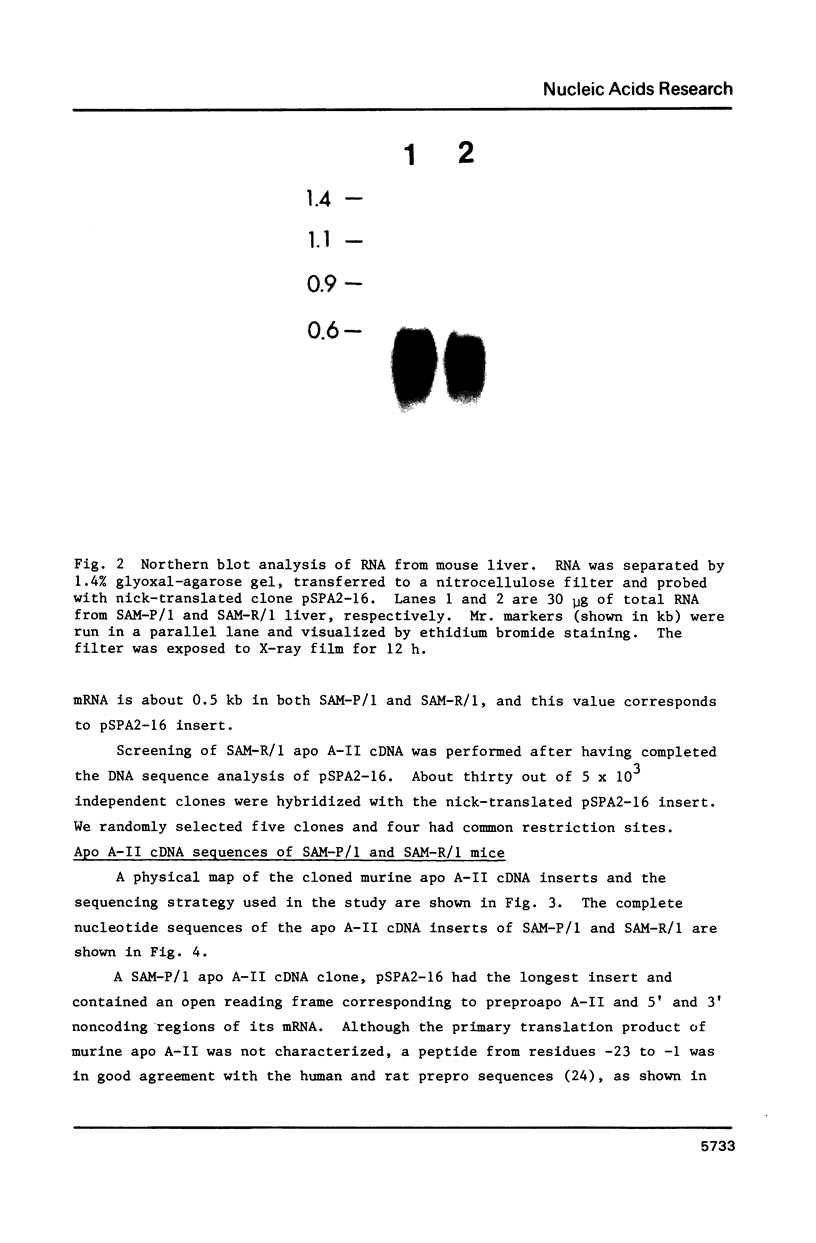
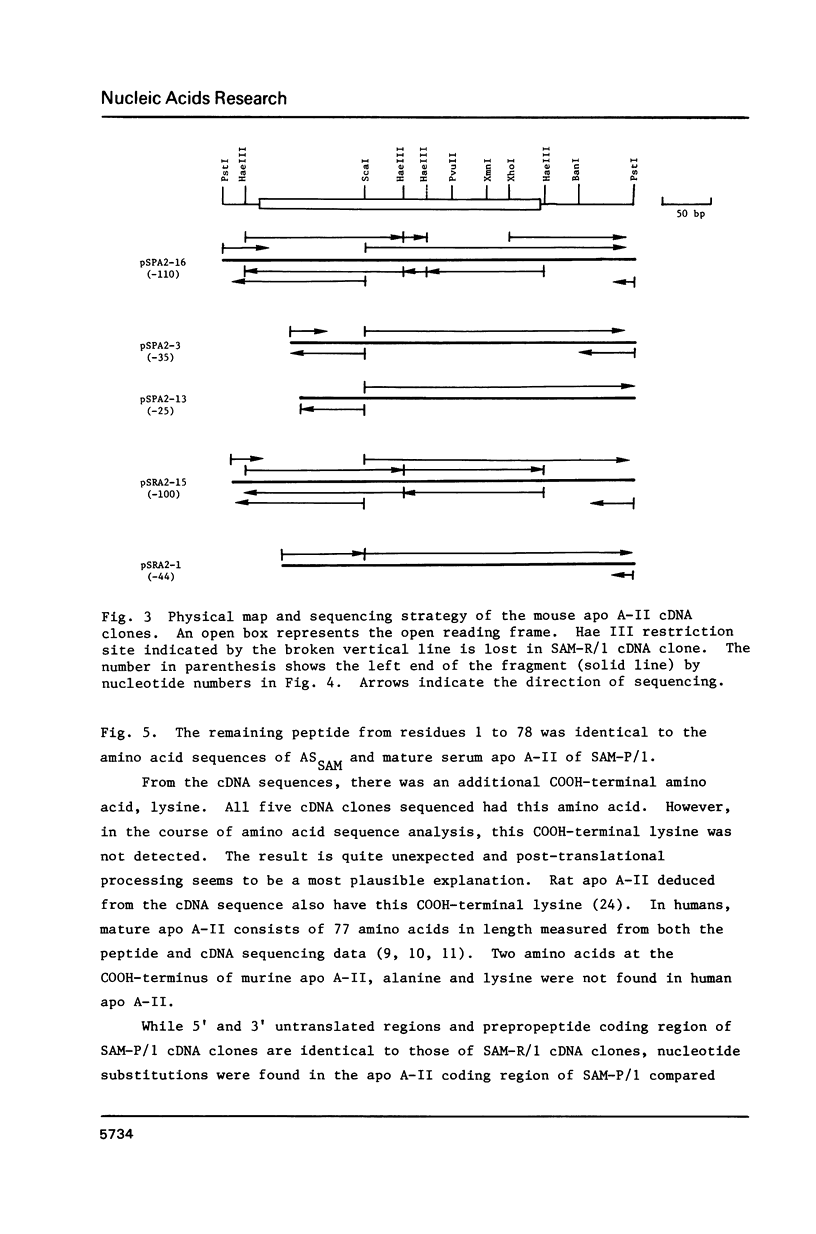
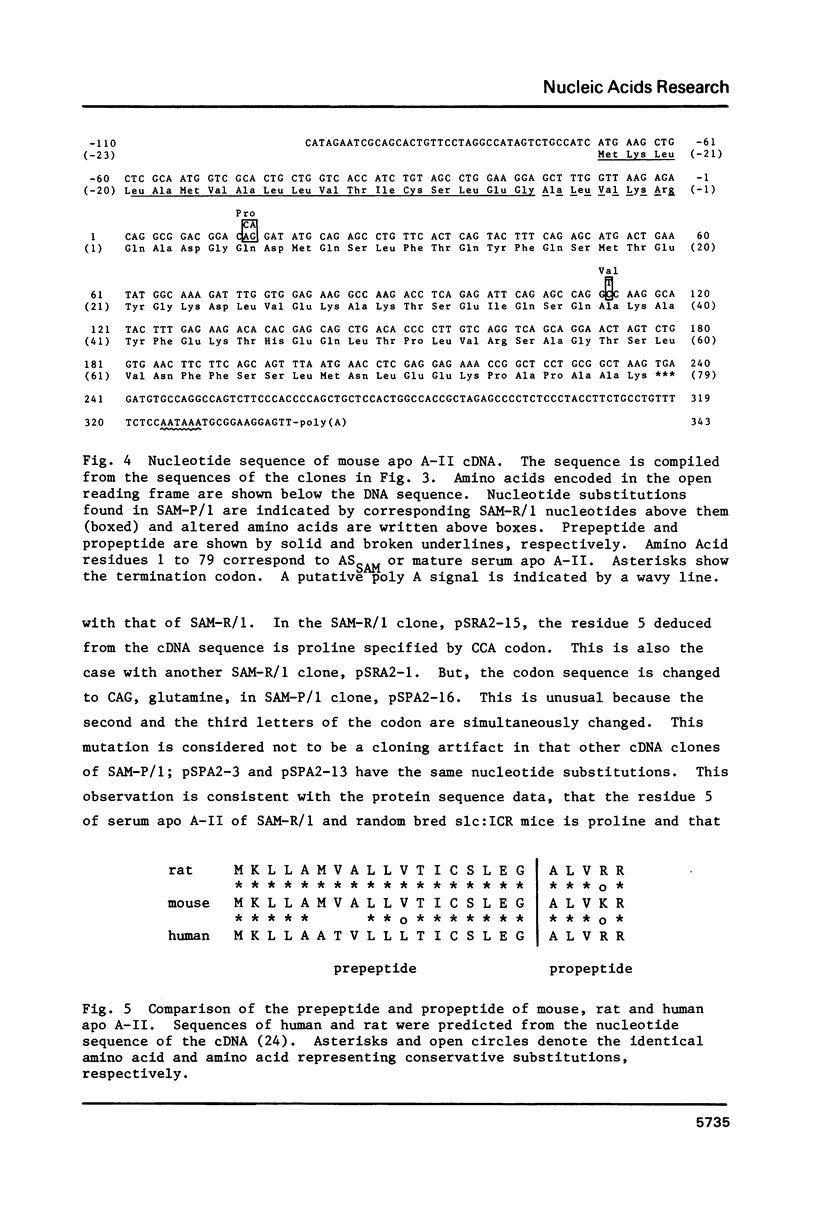
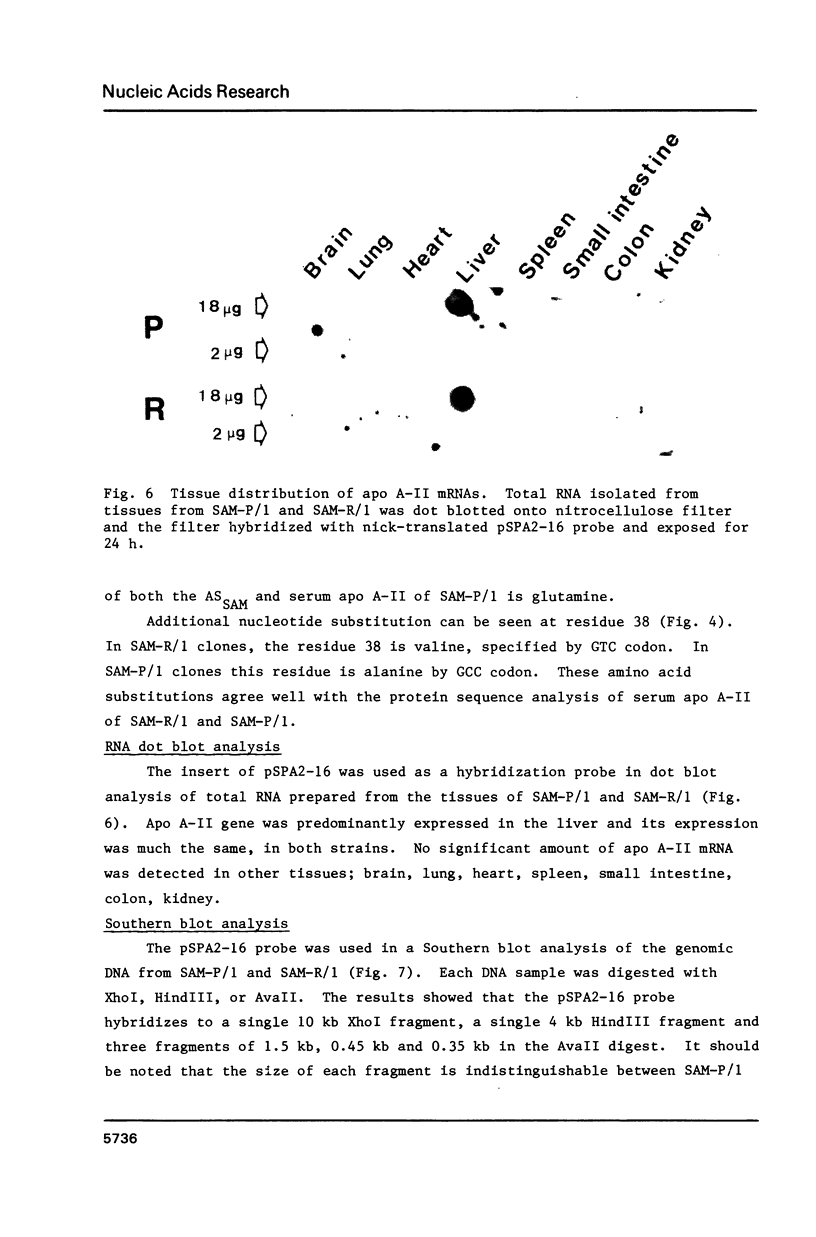
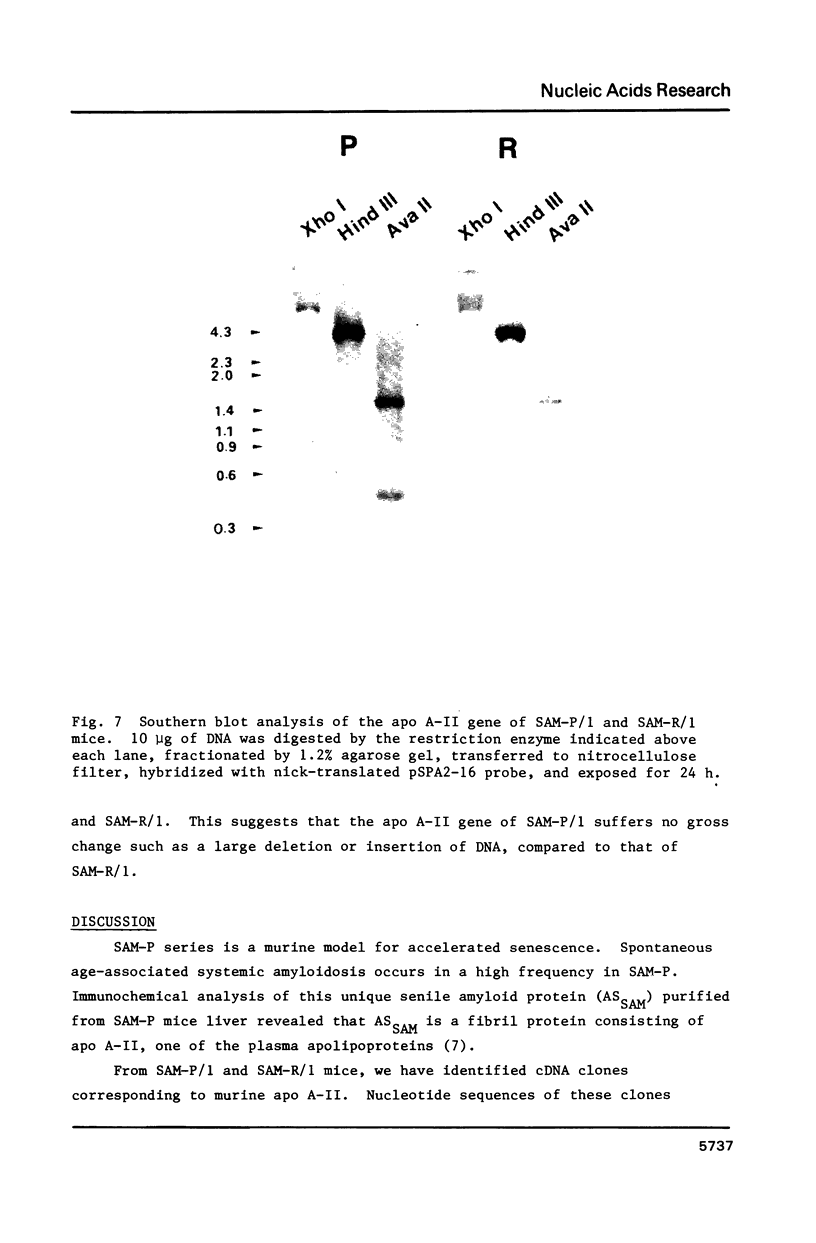
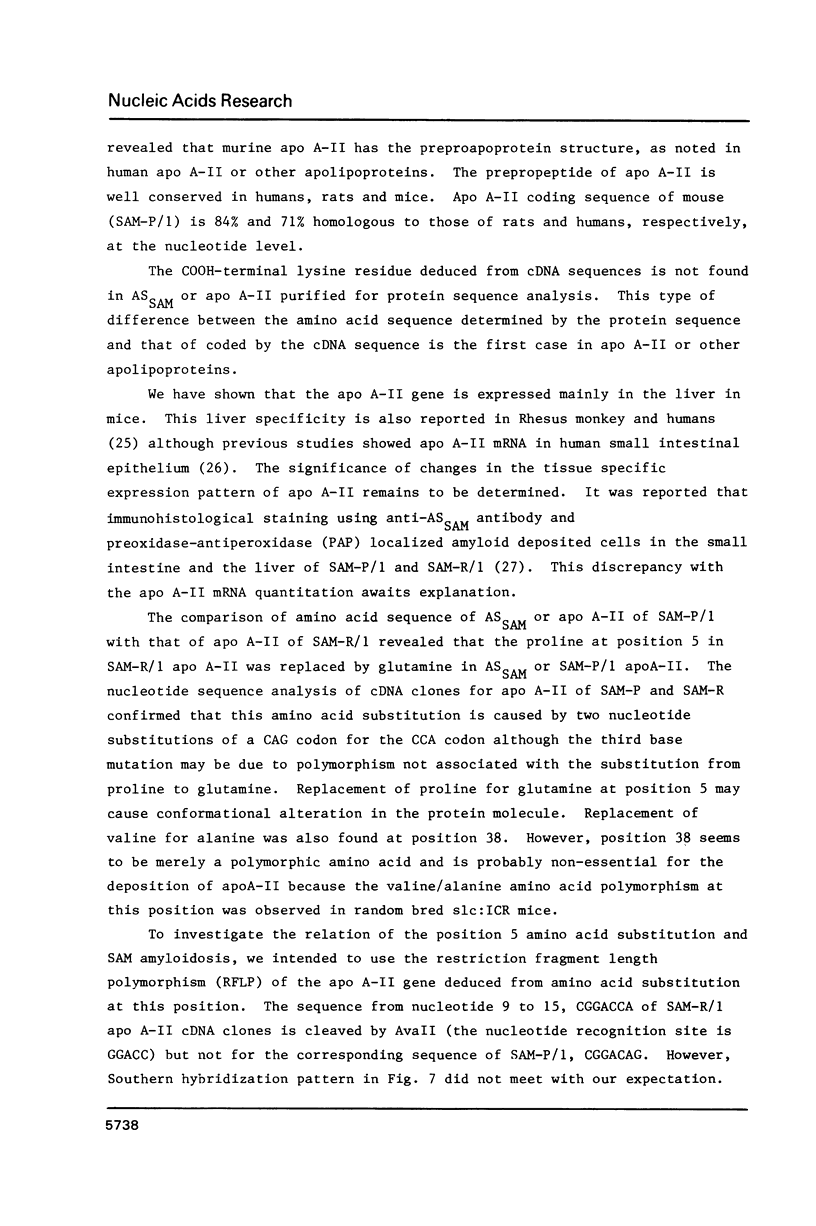
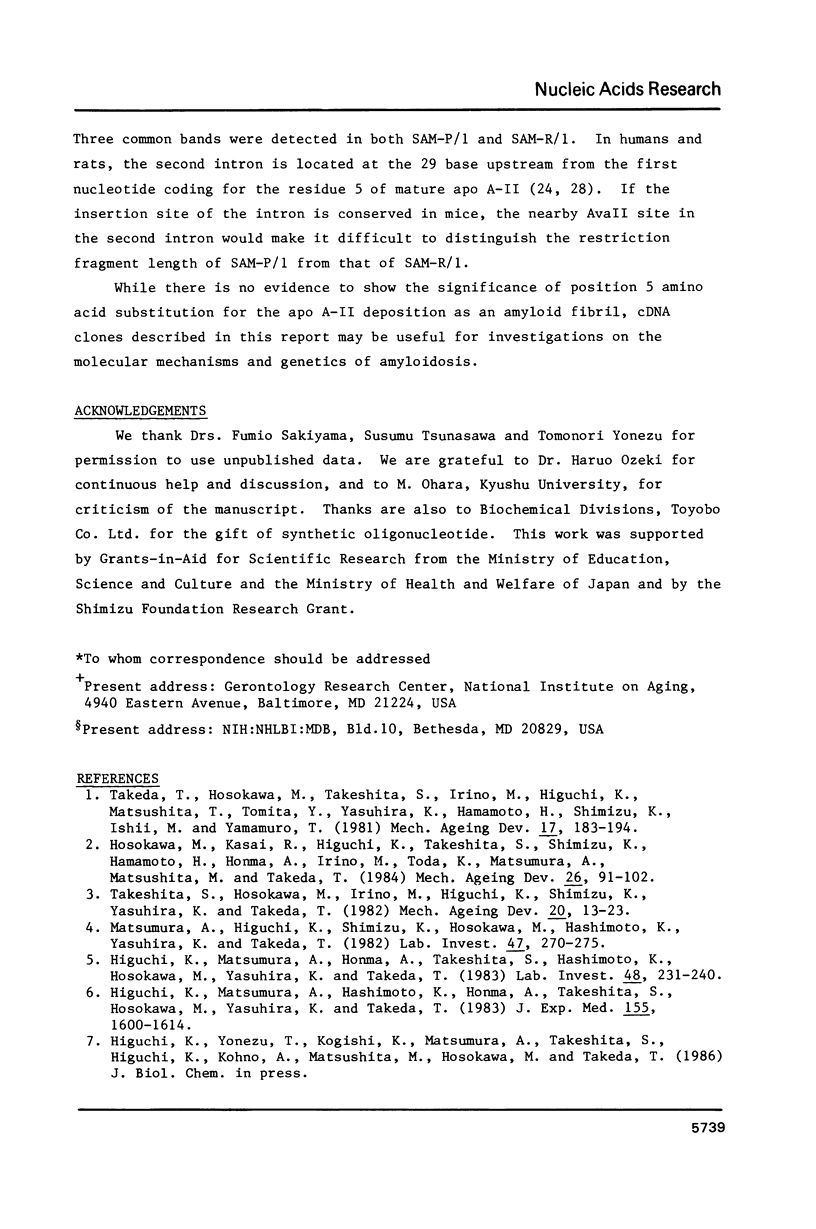
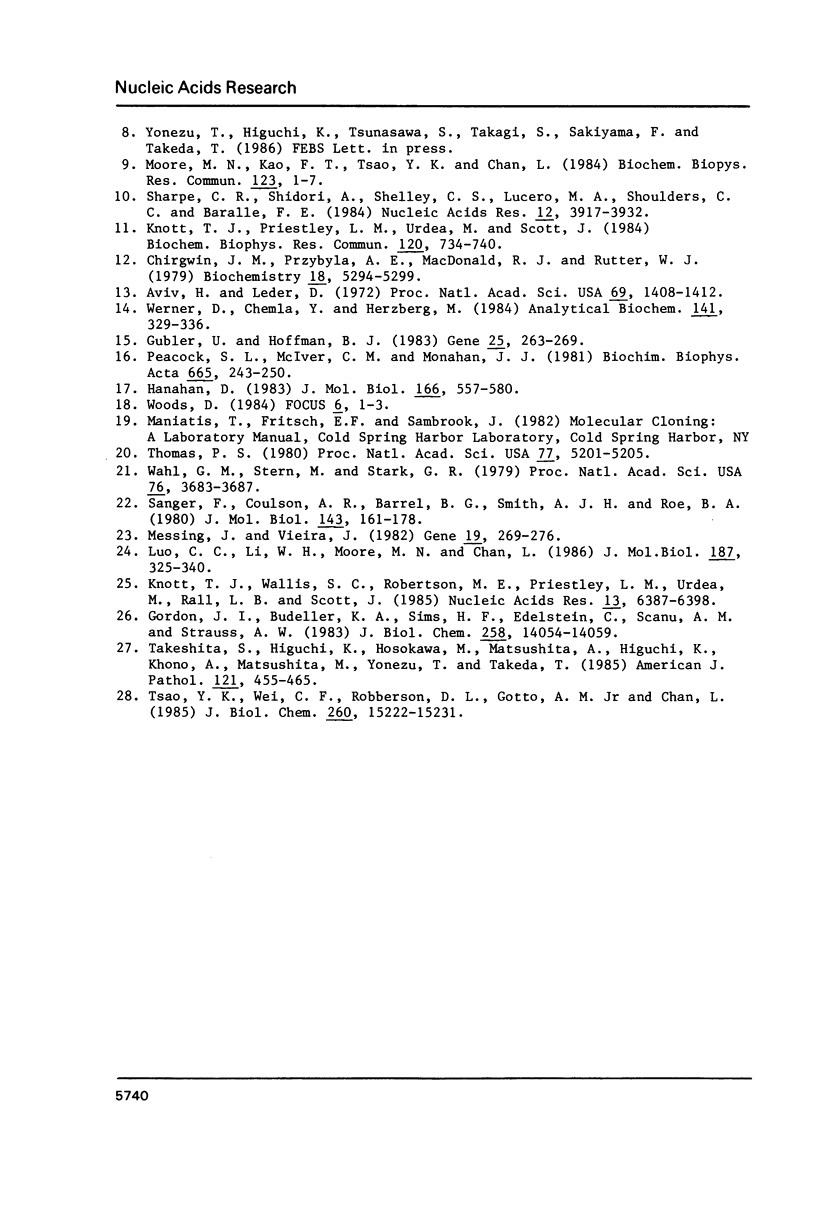
Images in this article
Selected References
These references are in PubMed. This may not be the complete list of references from this article.
- Aviv H., Leder P. Purification of biologically active globin messenger RNA by chromatography on oligothymidylic acid-cellulose. Proc Natl Acad Sci U S A. 1972 Jun;69(6):1408–1412. doi: 10.1073/pnas.69.6.1408. [DOI] [PMC free article] [PubMed] [Google Scholar]
- Chirgwin J. M., Przybyla A. E., MacDonald R. J., Rutter W. J. Isolation of biologically active ribonucleic acid from sources enriched in ribonuclease. Biochemistry. 1979 Nov 27;18(24):5294–5299. doi: 10.1021/bi00591a005. [DOI] [PubMed] [Google Scholar]
- Gordon J. I., Budelier K. A., Sims H. F., Edelstein C., Scanu A. M., Strauss A. W. Biosynthesis of human preproapolipoprotein A-II. J Biol Chem. 1983 Nov 25;258(22):14054–14059. [PubMed] [Google Scholar]
- Gubler U., Hoffman B. J. A simple and very efficient method for generating cDNA libraries. Gene. 1983 Nov;25(2-3):263–269. doi: 10.1016/0378-1119(83)90230-5. [DOI] [PubMed] [Google Scholar]
- Hanahan D. Studies on transformation of Escherichia coli with plasmids. J Mol Biol. 1983 Jun 5;166(4):557–580. doi: 10.1016/s0022-2836(83)80284-8. [DOI] [PubMed] [Google Scholar]
- Higuchi K., Matsumura A., Hashimoto K., Honma A., Takeshita S., Hosokawa M., Yasuhira K., Takeda T. Isolation and characterization of senile amyloid--related antigenic substance (SASSAM) from mouse serum. Apo SASSAM is a low molecular weight apoprotein of high density lipoprotein. J Exp Med. 1983 Nov 1;158(5):1600–1614. doi: 10.1084/jem.158.5.1600. [DOI] [PMC free article] [PubMed] [Google Scholar]
- Higuchi K., Matsumura A., Honma A., Takeshita S., Hashimoto K., Hosokawa M., Yasuhira K., Takeda T. Systemic senile amyloid in senescence-accelerated mice. A unique fibril protein demonstrated in tissues from various organs by the unlabeled immunoperoxidase method. Lab Invest. 1983 Feb;48(2):231–240. [PubMed] [Google Scholar]
- Hosokawa M., Kasai R., Higuchi K., Takeshita S., Shimizu K., Hamamoto H., Honma A., Irino M., Toda K., Matsumura A. Grading score system: a method for evaluation of the degree of senescence in senescence accelerated mouse (SAM). Mech Ageing Dev. 1984 Jul;26(1):91–102. doi: 10.1016/0047-6374(84)90168-4. [DOI] [PubMed] [Google Scholar]
- Knott T. J., Priestley L. M., Urdea M., Scott J. Isolation and characterisation of a cDNA encoding the precursor for human apolipoprotein AII. Biochem Biophys Res Commun. 1984 May 16;120(3):734–740. doi: 10.1016/s0006-291x(84)80168-0. [DOI] [PubMed] [Google Scholar]
- Knott T. J., Wallis S. C., Robertson M. E., Priestley L. M., Urdea M., Rall L. B., Scott J. The human apolipoprotein AII gene: structural organization and sites of expression. Nucleic Acids Res. 1985 Sep 11;13(17):6387–6398. doi: 10.1093/nar/13.17.6387. [DOI] [PMC free article] [PubMed] [Google Scholar]
- Luo C. C., Li W. H., Moore M. N., Chan L. Structure and evolution of the apolipoprotein multigene family. J Mol Biol. 1986 Feb 5;187(3):325–340. doi: 10.1016/0022-2836(86)90436-5. [DOI] [PubMed] [Google Scholar]
- Matsumura A., Higuchi K., Shimizu K., Hosokawa M., Hashimoto K., Yasuhira K., Takeda T. A novel amyloid fibril protein isolated from senescence-accelerated mice. Lab Invest. 1982 Sep;47(3):270–275. [PubMed] [Google Scholar]
- Messing J., Vieira J. A new pair of M13 vectors for selecting either DNA strand of double-digest restriction fragments. Gene. 1982 Oct;19(3):269–276. doi: 10.1016/0378-1119(82)90016-6. [DOI] [PubMed] [Google Scholar]
- Moore M. N., Kao F. T., Tsao Y. K., Chan L. Human apolipoprotein A-II: nucleotide sequence of a cloned cDNA, and localization of its structural gene on human chromosome 1. Biochem Biophys Res Commun. 1984 Aug 30;123(1):1–7. doi: 10.1016/0006-291x(84)90371-1. [DOI] [PubMed] [Google Scholar]
- Peacock S. L., McIver C. M., Monahan J. J. Transformation of E. coli using homopolymer-linked plasmid chimeras. Biochim Biophys Acta. 1981 Sep 28;655(2):243–250. doi: 10.1016/0005-2787(81)90014-9. [DOI] [PubMed] [Google Scholar]
- Sanger F., Coulson A. R., Barrell B. G., Smith A. J., Roe B. A. Cloning in single-stranded bacteriophage as an aid to rapid DNA sequencing. J Mol Biol. 1980 Oct 25;143(2):161–178. doi: 10.1016/0022-2836(80)90196-5. [DOI] [PubMed] [Google Scholar]
- Sharpe C. R., Sidoli A., Shelley C. S., Lucero M. A., Shoulders C. C., Baralle F. E. Human apolipoproteins AI, AII, CII and CIII. cDNA sequences and mRNA abundance. Nucleic Acids Res. 1984 May 11;12(9):3917–3932. doi: 10.1093/nar/12.9.3917. [DOI] [PMC free article] [PubMed] [Google Scholar]
- Takeda T., Hosokawa M., Takeshita S., Irino M., Higuchi K., Matsushita T., Tomita Y., Yasuhira K., Hamamoto H., Shimizu K. A new murine model of accelerated senescence. Mech Ageing Dev. 1981 Oct;17(2):183–194. doi: 10.1016/0047-6374(81)90084-1. [DOI] [PubMed] [Google Scholar]
- Takeshita S., Higuchi K., Hosokawa M., Matsumura A., Higuchi K., Kohno A., Matsushita M., Yonezu T., Takeda T. Morphologic demonstration of cytoplasmic ASSAM-related antigenic substance (CASSAM) by an immunoperoxidase technique. Am J Pathol. 1985 Dec;121(3):455–465. [PMC free article] [PubMed] [Google Scholar]
- Takeshita S., Hosokawa M., Irino M., Higuchi K., Shimizu K., Yasuhira K., Takeda T. Spontaneous age-associated amyloidosis in senescence-accelerated mouse (SAM). Mech Ageing Dev. 1982 Sep;20(1):13–23. doi: 10.1016/0047-6374(82)90070-7. [DOI] [PubMed] [Google Scholar]
- Thomas P. S. Hybridization of denatured RNA and small DNA fragments transferred to nitrocellulose. Proc Natl Acad Sci U S A. 1980 Sep;77(9):5201–5205. doi: 10.1073/pnas.77.9.5201. [DOI] [PMC free article] [PubMed] [Google Scholar]
- Tsao Y. K., Wei C. F., Robberson D. L., Gotto A. M., Jr, Chan L. Isolation and characterization of the human apolipoprotein A-II gene. Electron microscopic analysis of RNA:DNA hybrids, nucleotide sequence, identification of a polymorphic MspI site, and general structural organization of apolipoprotein genes. J Biol Chem. 1985 Dec 5;260(28):15222–15231. [PubMed] [Google Scholar]
- Wahl G. M., Stern M., Stark G. R. Efficient transfer of large DNA fragments from agarose gels to diazobenzyloxymethyl-paper and rapid hybridization by using dextran sulfate. Proc Natl Acad Sci U S A. 1979 Aug;76(8):3683–3687. doi: 10.1073/pnas.76.8.3683. [DOI] [PMC free article] [PubMed] [Google Scholar]
- Werner D., Chemla Y., Herzberg M. Isolation of poly(A)+ RNA by paper affinity chromatography. Anal Biochem. 1984 Sep;141(2):329–336. doi: 10.1016/0003-2697(84)90050-2. [DOI] [PubMed] [Google Scholar]



